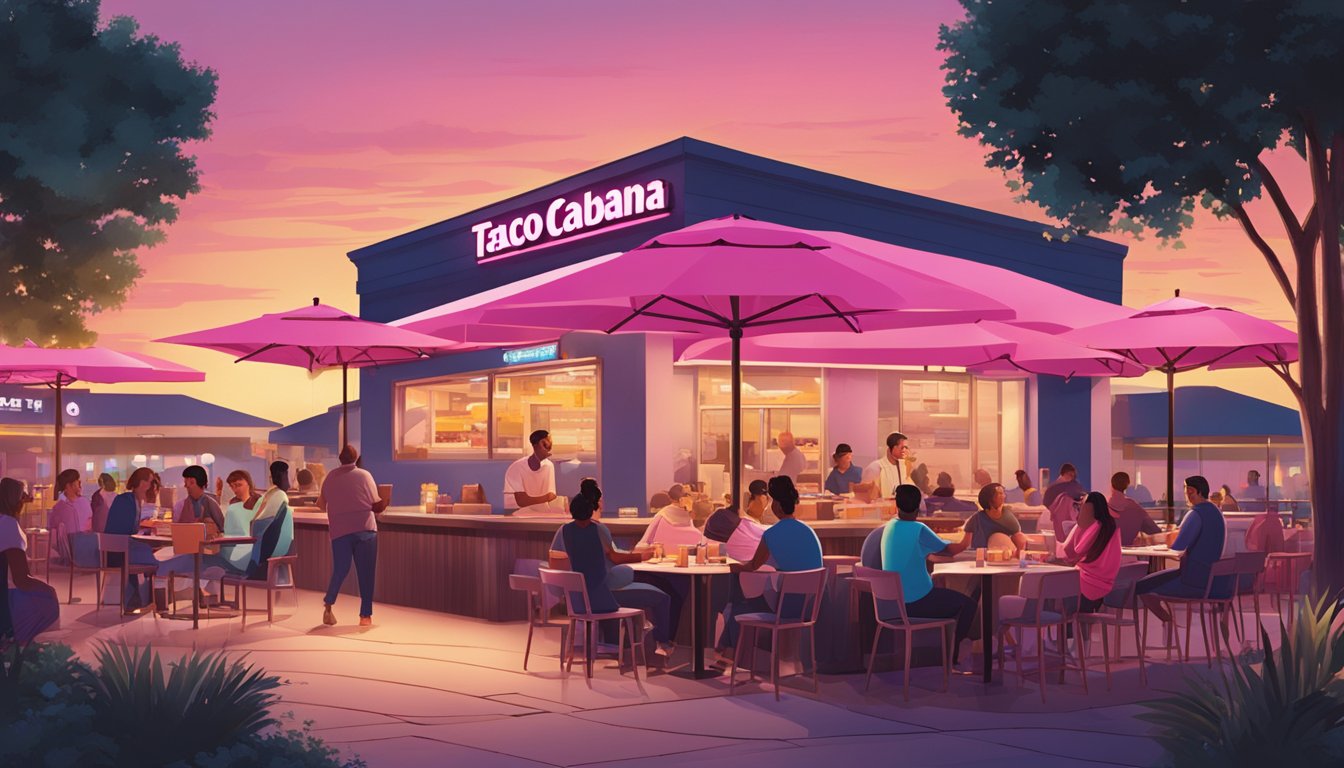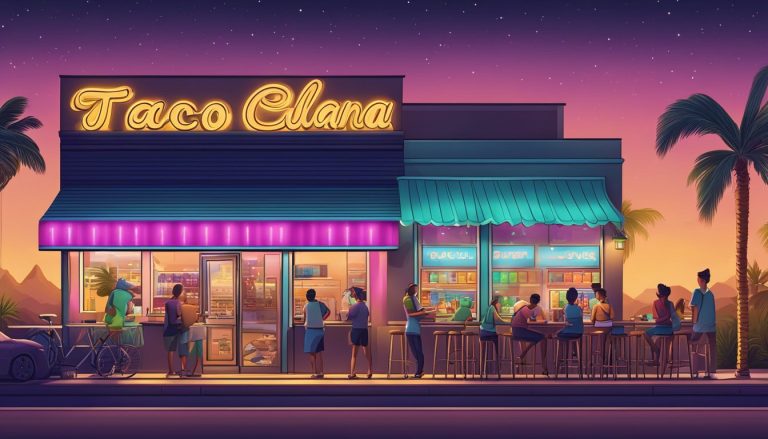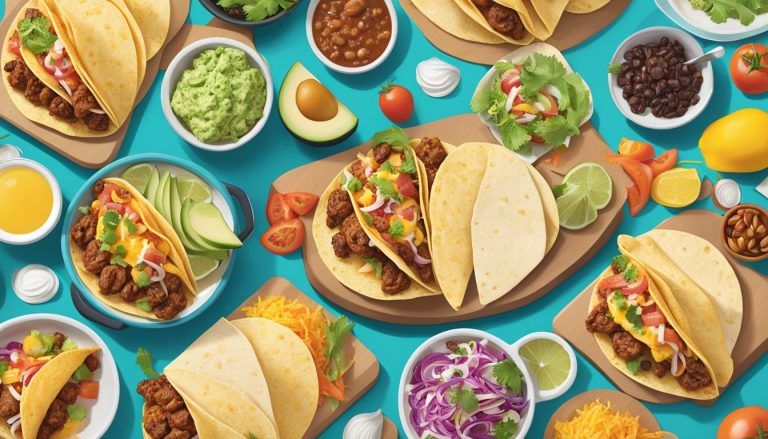Taco Cabana, a beloved Tex-Mex fast-casual chain, has become synonymous with its vibrant pink color scheme. Founded in San Antonio, Texas, the restaurant has embraced this eye-catching hue for over four decades. The iconic pink color has been a part of Taco Cabana’s brand identity since its inception in 1978, serving as a visual cue that sets it apart from other fast-food establishments.
The pink exterior and interior design elements have become a recognizable feature of Taco Cabana restaurants across Texas and neighboring states. This signature color extends beyond the building facades, appearing on signage, packaging, and even some menu items. The bold choice of pink reflects the company’s commitment to standing out in a competitive market while creating a welcoming atmosphere for diners.
Taco Cabana’s pink branding has evolved with the times, adapting to modern design trends while maintaining its core identity. Recent renovations have incorporated the classic pink into updated restaurant layouts, blending tradition with contemporary aesthetics. The enduring presence of this distinctive color demonstrates Taco Cabana’s dedication to its roots and its unique place in the Tex-Mex dining landscape.
History and Founding of Taco Cabana

Taco Cabana’s story begins in San Antonio, Texas in 1978. Felix Stehling’s vision and entrepreneurial spirit laid the foundation for what would become a beloved Tex-Mex fast-casual chain.
The Vision of Felix Stehling
Felix Stehling opened the first Taco Cabana in San Antonio in 1978. He saw an opportunity to serve fresh, affordable Tex-Mex food in a casual setting. The original location featured a distinctive pink color scheme and a semi-enclosed patio dining area.
Stehling focused on quality ingredients and made-from-scratch menu items. He aimed to provide fast service without compromising on taste or freshness. This approach set Taco Cabana apart from typical fast food restaurants.
From a Single Location to a Chain
The success of the first Taco Cabana led to rapid expansion. By the early 1980s, multiple locations opened across San Antonio. The chain’s popularity grew as customers appreciated its fresh food and efficient service.
Taco Cabana’s growth attracted imitators. The company faced legal challenges, notably against Two Pesos, a chain accused of copying Taco Cabana’s concept and decor. This lawsuit highlighted the brand’s distinctiveness.
As Taco Cabana expanded, it maintained its commitment to quality and its signature pink branding. The chain spread beyond San Antonio, establishing a presence throughout Texas and beyond.
Expansion and Ownership

Taco Cabana‘s growth trajectory has been marked by strategic acquisitions, market expansions, and ownership changes. These moves have shaped the company’s footprint and business model over the decades.
Key Acquisitions and Partnerships
Taco Cabana’s expansion was accelerated through key acquisitions. In 1992, the company acquired Two Pesos, a similar Tex-Mex chain with 30 locations. This move doubled Taco Cabana’s size and expanded its presence in Texas.
The chain also formed partnerships to enter new markets. It collaborated with franchise operators to establish locations in non-core areas, leveraging local expertise while maintaining brand consistency.
Growth Into New Markets
Taco Cabana initially focused on Texas, with strong presences in San Antonio, Dallas-Fort Worth, and Houston. The company gradually expanded into neighboring states.
By 2023, Taco Cabana had over 140 locations. The chain began exploring franchise opportunities in Arizona, Arkansas, Colorado, and Missouri, signaling a shift from its primarily company-owned model.
This expansion strategy aims to introduce Taco Cabana’s distinctive pink restaurants and Tex-Mex cuisine to new regional markets.
The Role of Carrols and Fiesta Restaurant Groups
Carrols Restaurant Group acquired Taco Cabana in 2000, integrating it into their portfolio of quick-service restaurants. This ownership change brought new resources and management expertise to the chain.
In 2012, Carrols spun off Taco Cabana and Pollo Tropical into Fiesta Restaurant Group. This move allowed for more focused management and growth strategies for the Tex-Mex brand.
In 2021, YTC Enterprises LLC acquired Taco Cabana from Fiesta Restaurant Group. This transition marked a new chapter for the chain, with renewed focus on its Texas roots and expansion plans.
The Restaurant Experience

Taco Cabana’s restaurant design blends functionality with a distinctive aesthetic. The chain’s approach to dining spaces, innovative self-serve options, and evolving restaurant prototypes have shaped its unique identity.
Distinctive Dining Area and Patio Design
Taco Cabana’s dining areas feature a signature semi-enclosed patio design. This architectural element creates a welcoming outdoor atmosphere while providing protection from the elements. The patios often incorporate vibrant colors, including the brand’s iconic pink.
Inside, the restaurants maintain an open layout. This design choice allows customers to view food preparation areas, emphasizing freshness and transparency. Seating options typically include booths and tables, accommodating various group sizes.
Innovation of the Salsa Bar
A standout feature of Taco Cabana is its self-serve salsa bar. This innovation allows customers to customize their meals with a variety of fresh salsas and condiments. The salsa bar concept enhances the dining experience by offering choice and interactivity.
Salsa options often range from mild to spicy, catering to different taste preferences. The bar usually includes staples like pico de gallo, jalapeño salsa, and various hot sauces. This self-serve model has become a key part of Taco Cabana’s brand identity.
Babcock Road Prototype and Iterations
The Babcock Road location in San Antonio served as a prototype for Taco Cabana’s evolving restaurant design. This site introduced new elements that would shape future locations. Key features included an expanded kitchen area and modernized dining spaces.
Subsequent iterations of the restaurant design have built upon this prototype. Changes have included updated color schemes, more efficient kitchen layouts, and enhanced drive-thru capabilities. These design evolutions aim to improve customer experience and operational efficiency.
Recent updates have incorporated digital ordering kiosks and revised seating arrangements. These changes reflect the chain’s adaptation to changing consumer preferences and technological advancements in the fast-casual restaurant sector.
The Menu’s Evolution

Taco Cabana’s menu has grown and adapted over the years, reflecting its Tex-Mex roots and commitment to fresh, flavorful cuisine. The chain has introduced new items while maintaining its core offerings.
Signature Menu Items and Texas Flavors
Taco Cabana’s menu showcases a blend of Tex-Mex favorites and unique creations. Fajitas remain a popular choice, with their signature sizzle and bold flavors. The chain’s Texas Smokehouse Brisket tacos have become a standout item, combining slow-cooked beef with traditional taco fixings.
Carne guisada, a hearty beef stew, offers customers a taste of authentic Mexican comfort food. Chicken quesadillas provide a classic option for those craving melted cheese and grilled meat.
Enchiladas round out the menu with their savory filling and rich sauce. Fresh pico de gallo adds a zesty touch to many dishes.
The Introduction of Breakfast Tacos
Recognizing the demand for quick, satisfying morning meals, Taco Cabana introduced breakfast tacos to its menu. These handheld delights feature a variety of fillings wrapped in warm tortillas.
Popular breakfast taco options include egg and cheese, bacon and egg, and potato and egg. The chain also offers heartier combinations like chorizo and egg or bean and cheese.
Breakfast tacos have become a signature item, attracting early risers and late-night diners alike. Their success demonstrates Taco Cabana’s ability to adapt to changing customer preferences.
Maintaining Freshness and Quality
Taco Cabana prides itself on using fresh ingredients and preparing food on-site. The chain’s commitment to quality is evident in its made-from-scratch tortillas and salsas.
Each restaurant features an open kitchen, allowing customers to see their food being prepared. This transparency reinforces the chain’s dedication to freshness.
Taco Cabana sources ingredients locally when possible, supporting regional suppliers and ensuring the flavors stay true to their Tex-Mex roots. The chain’s focus on quality ingredients and careful preparation has helped maintain its reputation for tasty, authentic cuisine.
Marketing and Customer Engagement

Taco Cabana employs innovative strategies to attract and retain customers. The brand leverages digital platforms and enticing promotions to boost engagement and sales.
Embracing Digital and Online Ordering
Taco Cabana has modernized its approach to meet changing consumer preferences. The company launched a user-friendly mobile app and website for convenient online ordering. These platforms allow customers to browse menus, customize orders, and schedule pickup or delivery times.
Taco Cabana also maintains an active social media presence. The brand shares menu updates, promotions, and behind-the-scenes content on platforms like Instagram and Facebook. This digital engagement helps foster a connection with younger demographics and keeps loyal customers informed.
Special Promotions and $2 Margaritas
Taco Cabana’s signature alcoholic beverages play a crucial role in its marketing efforts. The chain’s popular $2 margarita promotions have become a major draw for customers. These deals typically feature rotating flavors, encouraging repeat visits to try new varieties.
Beyond margaritas, Taco Cabana runs seasonal promotions and limited-time offers on food items. These specials create a sense of urgency and excitement among customers. The brand also implements loyalty programs, rewarding frequent visitors with exclusive deals and perks.
Corporate Management and Strategy

Taco Cabana’s management decisions and financial strategies have shaped its growth over the years. Key leadership changes and financial milestones have played crucial roles in the company’s evolution.
Leadership Transitions and Richard Cervera
Richard Cervera joined Taco Cabana as CEO in 1994, bringing extensive restaurant industry experience. Under his leadership, the company expanded its menu offerings and improved operational efficiency. Cervera focused on maintaining the brand’s Tex-Mex roots while adapting to changing consumer preferences.
He oversaw the expansion of Taco Cabana’s footprint across Texas and into neighboring states. Cervera’s tenure saw the implementation of new technologies to streamline ordering and food preparation processes.
Financial Milestones and Public Offering
Taco Cabana reached a significant financial milestone in 1992 when it went public. The initial public offering (IPO) raised capital for further expansion and modernization efforts.
The company’s stock was listed on the NASDAQ exchange, increasing its visibility to investors. This move allowed Taco Cabana to access new sources of funding for growth initiatives and store renovations.
In 2000, Carrols Restaurant Group acquired Taco Cabana, leading to further changes in corporate strategy. The acquisition provided additional resources for menu development and marketing campaigns.
Cultural Impact and Tex-Mex Identity

Taco Cabana’s vibrant pink color has become a symbol of Tex-Mex culture and identity in Texas and beyond. The chain’s visual branding reflects its roots and commitment to creating an authentic dining experience.
Headquartered in San Antonio and Texas Pride
Taco Cabana’s San Antonio headquarters underscores its deep connection to Texas culture. The restaurant chain proudly embraces its Texan heritage, incorporating local flavors and traditions into its menu and ambiance.
The pink color serves as a nod to the vibrant hues found in traditional Mexican and Tex-Mex art. This visual identity helps Taco Cabana stand out among competitors while reinforcing its regional roots.
Texans often view Taco Cabana as a homegrown success story. The chain’s expansion across the state has further cemented its status as a beloved Tex-Mex institution.
Fiesta Atmosphere and Papel Picado Decor
Taco Cabana’s pink branding extends beyond its exterior, creating a festive atmosphere inside its restaurants. The cheerful color scheme evokes the spirit of Mexican fiestas, inviting customers to relax and enjoy their meals.
Papel picado, a traditional Mexican paper craft, features prominently in Taco Cabana’s decor. These intricate, colorful banners complement the pink theme and add an authentic touch to the dining experience.
The combination of pink walls, papel picado, and other cultural elements creates a unique ambiance. This immersive environment helps transport diners to a Tex-Mex oasis, even in the middle of busy urban areas.




